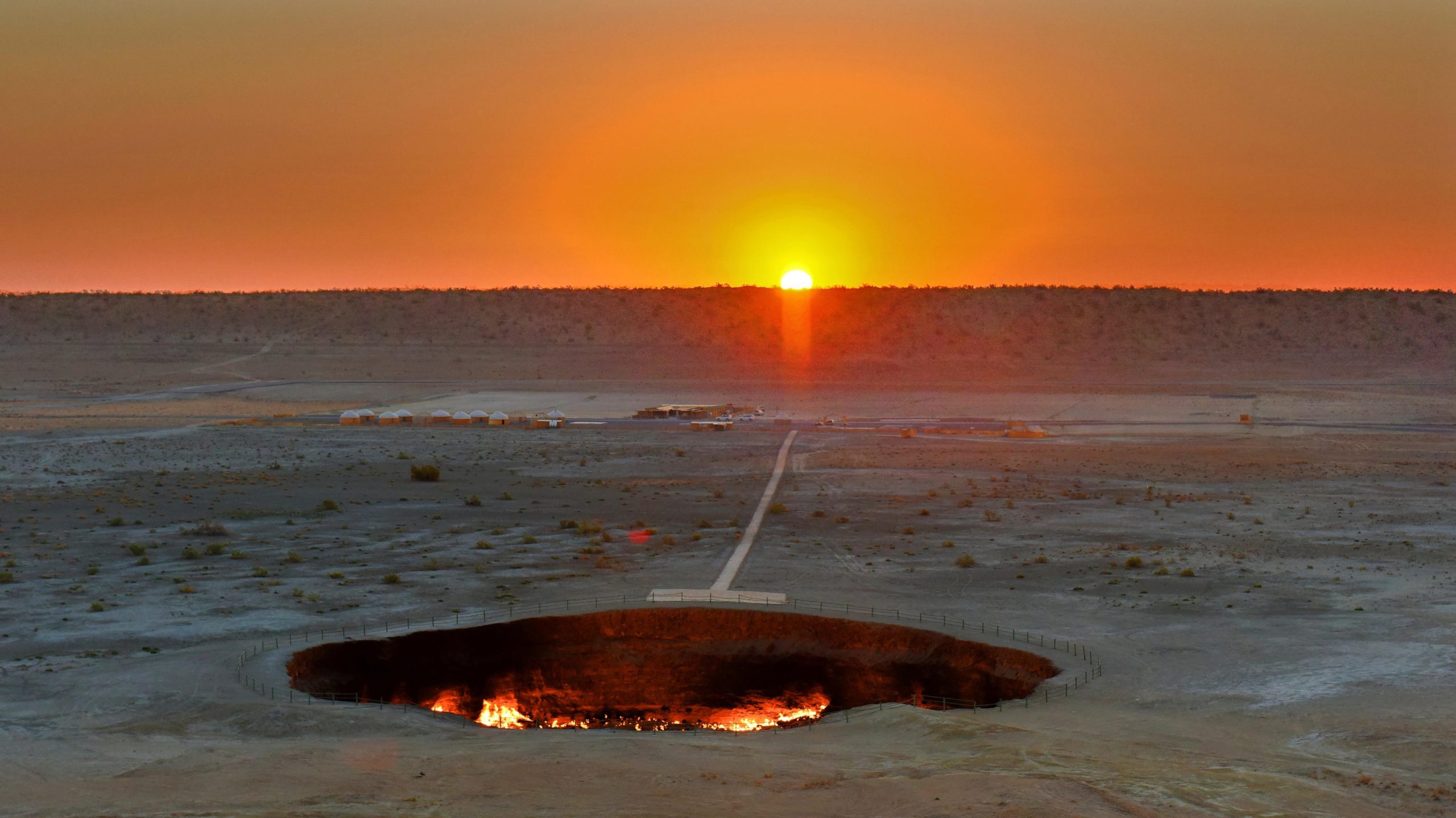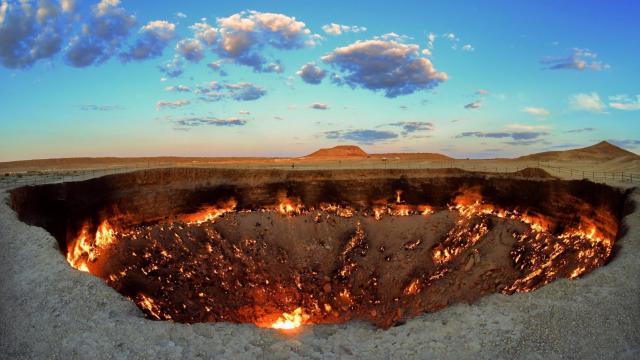OK, who put “Turkmenistan is going to attempt to extinguish the eternal fires of the Gateway of Hell” on their 2022 bingo card? Anyone? No? Right then.
Within the Central Asian nation’s expansive Karakum Desert, somewhere just north of its centre, lies Darvaza Crater, more commonly known as the Gateway to Hell. Although its dimensions — 70 metres across and 30 metres deep — aren’t that impressive, the perpetual conflagration within certain is: Methane-fuelled fires have been burning down there for perhaps half a century, like the world’s most overzealous barbecue pit. For some strange reason, as the new year dawned, Turkmenistan’s authoritarian President Gurbanguly Berdymukhamedov decided he’d had enough of Darvaza’s incandescence.
During televised remarks made earlier this month, he said that the crater — one far from any permanent human population — was a health and safety hazard and an environmental risk. He also implied that the natural gas going up in flames could be tapped and used as fuel. “We are losing valuable natural resources for which we could get significant profits and use them for improving the well-being of our people,” Berdymukhamedov noted. Officials, he said, had been ordered to “find a solution to extinguish the fire.”
But… how exactly does one extinguish a seemingly eternal fire? And, frankly, why the hell would anyone even try to do battle with this demonic geologic force?
In recent years, the crater has become something of a tourist attraction. It’s certainly a spectacular sight, particularly at night: Under a canopy of stars, the unyielding pyre within Darvaza (which means “gateway” or “doorway”) flickers and hisses as the darkness above.
The “of hell” part of the locale’s name is “100% understandable,” George Kourounis, an explorer and documentarian, said. If you peer over the rim, the heat roars into your face as if you’re standing in front of a blast furnace. “You expect to see the devil waving back at you,” he said.
Back in 2013, Kourounis enjoyed the spectacle so much that he climbed into the crater itself, becoming the first and, to date, only person to have done so. (On record, anyways.) Attached to a complex pulley system, he carefully made his way down to the crater floor courtesy of his Kevlar-imbued fireproof harness and a heat-deflecting suit, the sort occasionally donned by volcanologists. He spent no more than 17 minutes down there, gathering soil samples as he went so scientists could check to see whether this Hadean pit was home to any extremely hardy microorganisms.
It turns out the crater floor was indeed full of confounding critters, an astounding find considering how dynamic and precarious the environment was. “When I was digging and gathering these soil samples, fire would come up through the hole that I was digging, because I would open up new paths for the methane,” Kourounis said.
The Gateway to Hell gets all the glory. But to understand its origin story — and how to quench its unending flames — you need to pan out a bit wider. The landscape is home to two other bubbling, gassy craters, one full of water, the other a muddy mess filled with weak flames. The region overlies the colossal Amu-Darya Basin, a giant geologic bowl that “has lots and lots of oil and gas fields” dating back to the Jurassic, said Mark Tingay, a petroleum geomechanics expert at the University of Adelaide. And over time, that vast methane reservoir leaks, and “it just bleeds up” to the surface.
This voluminous supply of flammable methane has sparked long-lived fires throughout this part of Central Asia, from Uzbekistan to Azerbaijan. Darvaza Crater’s gas supply sits just 500 metres or so below ground, an easily accessible source of essentially unending fuel. The earthen depression shields the fires from strong winds, which has allowed them to burn uninterrupted for generations.

But nature isn’t the sole pyromaniac here. The ignominious role of firestarter likely goes to humanity (of course). The true story of how the flames first emerged is buried in Cold War era secrecy: If any photographs or verifiable written accounts of the ignition exist, Turkmenistan, a former Soviet nation turned authoritarian sovereign nation, is unlikely to give them up.
An oft-cited version of events that led to hellfire on Earth is that Soviet engineers were drilling in the region back in the 1960s or 1970s, perhaps looking for fossil fuel caches. The ground collapsed, unleashing a torrent of toxic methane. Burning off the gas seemed like the best way to deal with the situation. Hoping to light a match, throw it in, and quickly burn out the fuel supply, scientists were stunned when the fires persisted through hours, days, weeks, months, and, eventually, years. Oops.
“There are variations on that tale,” said Tingay, but this misadventure remains the most popular, “and a story becomes fact when it’s repeated enough times.”
President Berdymukhamedov has a weird love-hate relationship with the scorching maw. In 2010, he announced that the fires were to be nixed, but nothing came of it. After rumours of his death circulated in 2019, footage emerged apparently showing him doing doughnuts near the crater in a rally car, an extremely metal way to show the haters that you’re still alive. But with Berdymukhamedov’s latest announcement, “it feels to me like they mean it this time,” said Kourounis.
The notion that this very remote crater is a safety risk to people is silly, though. (There used to be a village nearby, but it was razed by soldiers in 2004 on a former president’s orders.) Environmentally, it is hardly an issue either. Methane is a short-lived but highly damaging greenhouse gas about 80 times more potent than carbon dioxide. But when it’s set alight, it becomes water and carbon dioxide, the latter being a still terrible but less potent warming agent. Either way, compared to the nation’s industrial and commercial activities, Tingay said Darvaza is a “pretty tiny contribution to the carbon budget.”
“It’s not hurting anyone,” said Guillermo Rein, a fire scientist at Imperial College London with a most apt surname. So why squelch out its flames? “Methane is a valuable resource. Maybe someone wants to capture it and use it,” he said. Additionally, said Kourounis, “I think they’re embarrassed by it, the fact that this industrial accident has gotten world attention.”
Still, this begs the question of whether this is a Sisyphean endeavour, or one that could have a successful ending? Like any fire, the Gateway to Hell can be put out if you take out one of its three key components, said Ed Galea, the fire safety research group leader at the University of Greenwich. Fires require fuel, heat, and an oxidizing agent (often oxygen itself). “You take one of those away, and the fire goes out,” Galea said.
Getting rid of the fuel — in this case, the huge methane reservoir — is not plausible. But you could asphyxiate the fire; a staggering volume of foams or halons, the stuff you find in common fire extinguishers, could be sprayed en masse into Darvaza, robbing the flames of their precious oxygen. Alternatively, you could build a metallic canopy near the crater and slide it on top, like a giant fire blanket.
Lower tech options may also work. “If you filled the whole crater with dirt, that would probably put out the fire,” said Tingay. “But it wouldn’t stop the gas from leaking out.” If you wanted to capture the methane, then that theoretically wouldn’t be an issue. This method would, however, require a high-fidelity geologic map of the many rocky pathways the gas could use to escape — unless you don’t mind flammable gas coming out of the ground, perhaps miles from Darvaza, in an unpredictable fashion.
Conversely, if you wanted to absolutely guarantee that the crater would no longer be home to an eternal fire, you would have to find a way to block or sever the pathways allowing that subterranean methane to seep out in the first place. This has precedent: Every now and then, an industrial well atop a hydrocarbon field hits some natural gas and ignites. On occasion, engineers have drilled a borehole and dropped a bomb down it, or placed a bomb next to the surface fires, and triggered the detonator to terminate a fire. The blast violently removes the fire-feeding oxygen and shifts a lot of rock around. That causes the gas escape conduits to collapse in on themselves, leaving the gas imprisoned below ground and the flames permanently quenched.
If that was to be Darvaza’s fate, then “you’d need a massive explosion to close off all the faults and fractures,” Tingay said.
A quick peek at Cold War history hints at the magnitude of what would likely be needed. Back in 1963, a gas well in Uzbekistan erupted into an accidental inferno and burned steadily for three years. By 1966, Soviet officials decided to go the route of setting off a conduit-blocking bomb below ground. In their hour of desperation, officials quite literally chose the nuclear option.
“They used a nuke,” Tingay said.
The potent blast didn’t just rearrange the buried labyrinth with shocking violence; it liquefied plenty of rock, which then quickly froze into a glass, effectively sealing shut any and every route that gas had to the surface. With that, the fire went out. “It worked. It’s a pretty extreme measure, I wouldn’t recommend it,” said Tingay. “But it did work.”
Nukes were all the rage during the Cold War: both the Soviet Union and the U.S. had grand plans for the use of so-called peaceful nuclear detonations, schemes known as Nuclear Explosions for the National Economy and Operation Plowshare, respectively. It would be amazing, they said! Imagine just how quickly you could dig canals, mine for minerals, and speed up construction work! Just, you know, ignore all that pesky radiation.
As you might expect, those radiation concerns could not be swept aside, though, and these two projects fortunately failed to make it mainstream. Despite proving effective at culling another troublesome natural gas fire, it is unlikely that a nuclear device will be used to end Darvaza’s reign of terror. Turkmenistan officials might instead opt for a really big conventional bomb, though, and, in Rein’s words, “cross their fingers that this will break the continuity of the gas flow.” (Although saying that, during the 2010 Deepwater Horizon oil leak in the Gulf of Mexico, both Russian and American nuclear experts suggested that a nuclear bomb might be a cheap and effective way to seal the leak’s subterranean pathways. So you never know.)
No matter how it’s approached, “the act of snuffing out this fire would be extremely difficult and expensive,” Kourounis said. After calculating the exhaustive cost of fixing this venerable anthropogenic whoopsie, state officials could ultimately decide to back out again, as they did in 2010.
But if Berdymukhamedov is indeed deadly serious this time around, then the firefighters involved must go all-in. Dousing the burning Gateway of Hell is not a time for half-measures. If a single methane pathway is left unobstructed and open to the air, one errant spark could revive the flames. “If they don’t have the resources to do this well, then I would say don’t touch it,” said Rein. “You do it properly, or you leave it.”
“Honestly,” said Tingay. “I would just leave it alone.”
